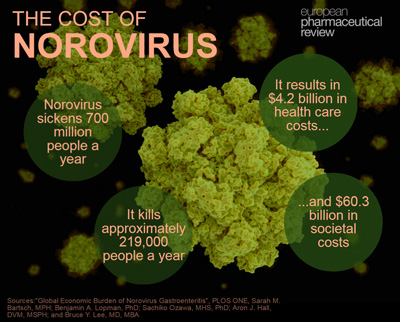The global cost of norovirus
Posted: 26 April 2016 | | No comments yet
Norovirus results in roughly $4.2 billion in health care costs and $60.3 billion in societal costs annually, a new study has found…


Norovirus sickens nearly 700 million around the world every year and results in roughly $4.2 billion in health care costs and $60.3 billion in societal costs annually, new Johns Hopkins Bloomberg School of Public Health research suggests.
The findings are believed to be the first to look at the global economic burden of norovirus, which is common in both wealthy and poor nations. The researchers say their study suggests that much more attention and education are needed to combat a disease that also kills approximately 219,000 a year around the world.
Bruce Y. Lee, MD, MBA, an associate professor in the Department of International Health at the Bloomberg School: “The costs associated with norovirus are high — higher than for many diseases, including rotavirus, that have gotten a lot more attention. Our study presents an economic argument for greater consideration of norovirus. It has been flying under the radar for too long.”
Norovirus is an easily transmissible virus that can cause severe gastrointestinal symptoms, including nausea, diarrhoea and vomiting. While it is most often discussed in relation to outbreaks, less than one percent of cases are associated with outbreaks. The researchers say that norovirus is not routinely tested for and the number of cases may be an underestimate. There is not yet a vaccine or a treatment for norovirus.
In contrast, the burden of rotavirus, a diarrhoeal disease that kills many babies but rarely endangers anyone over age five, was estimated at $2 billion a year before a vaccine was rolled out.
Lost productivity make up 94% of the economic burden of norovirus
For their study, the researchers developed a computer model to estimate both the costs of the medical burden (such as clinic visits and hospitalisations) and the other economic costs, most notably loss of productivity. Productivity losses are due to missed work due to illness, caring for a sick child, underperforming at work while sick and premature mortality. Their model estimated the cost for 233 countries, regions and territories in the world for which the United Nations has population data.
“Lost productivity is a big part of the cost,” Lee says. “By just focusing on health care costs, or simple measures such as death caused by the disease, we miss a lot of the burden. Productivity losses tend to go unrecognised, but make up 94 percent of the global economic burden of norovirus.”
The researchers say they hope their work will inform funding agencies and public health bodies regarding where to best allocate limited resources for intervention and control measures, including educational measures to prevent its spread.
Proper hand washing, maintaining health precautions during food preparation, improving food and water sources and keeping those who are sick with norovirus from coming into contact with others are some methods for protecting against the disease. The high costs associated with norovirus demonstrate the potential value of developing new technologies and approaches to detect, prevent and treat norovirus infections.



